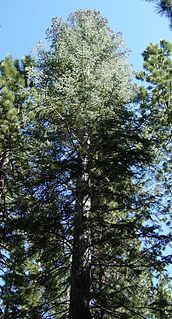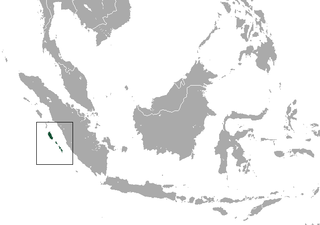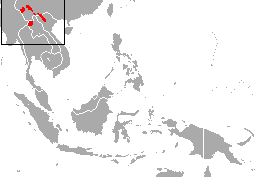
The cougar, also commonly known by other names including catamount, mountain lion, panther, and puma, is a large felid of the subfamily Felinae native to the Americas. Its range, from the Canadian Yukon to the southern Andes of South America, is the widest of any large wild terrestrial mammal in the Western Hemisphere. An adaptable, generalist species, the cougar is found in most American habitat types. It is the biggest cat in North America, and the second-heaviest cat in the New World after the jaguar. Secretive and largely solitary by nature, the cougar is properly considered both nocturnal and crepuscular, although daytime sightings do occur. The cougar is more closely related to smaller felines, including the domestic cat, than to any species of subfamily Pantherinae, of which only the jaguar is native to the Americas.

Firs (Abies) are a genus of 48–56 species of evergreen coniferous trees in the family Pinaceae. They are found through much of North and Central America, Europe, Asia, and North Africa, occurring in mountains over most of the range. Firs are most closely related to the genus Cedrus (cedar). Douglas firs are not true firs, being of the genus Pseudotsuga.

Abies concolor, the white fir, is a coniferous tree in the pine family Pinaceae. This tree is native to the mountains of western North America from the southern Cascade range in Oregon, south throughout California and into the Sierra de San Pedro Mártir in northern Baja California; west through parts of southern Idaho, to Wyoming; and south throughout the Colorado Plateau and southern Rocky Mountains in Utah and Colorado, and into the isolated mountain ranges of southern Arizona, New Mexico and northern Mexico. White fir live over 300-years and naturally occur at an elevation between 900–3,400 m (2,950–11,200 ft).

The pig-tailed langur, monotypic in genus Simias, is a large Old World monkey, endemic to several small islands off the coast of Sumatra in Indonesia. Its face is black, its fur is blackish-brown and it has a relatively short tail. It is a diurnal species, feeding in small groups in the rainforest canopy on leaves, and to a lesser extent, fruit and berries. Little is known of its natural history, but it is heavily hunted, its populations have been declining rapidly and the International Union for Conservation of Nature has assessed its conservation status as being "critically endangered". It has been included on a list of the World's 25 Most Endangered Primates.

The southern white-breasted hedgehog, sometimes referred to as white-bellied hedgehog or white-chested hedgehog, is a hedgehog of Southwestern Asia. It is very similar in lifestyle and appearance to the European hedgehog, but the former has a white spot on its chest. For a long time these two species were considered to be one. The northern white-breasted hedgehog of Eastern Europe and Russia was formerly recognized as a subspecies of the southern white-breasted hedgehog but newer investigations see both as different species. The southern white-breasted hedgehog and European hedgehog can hybridize.

Nomascus is the second-most speciose genus of gibbons. Originally, this genus was a subgenus of Hylobates, and all individuals were considered one species, Hylobates concolor. Species within Nomascus are characterized by 52 chromosomes. Some species are all black, some are light with a distinct black tuft of crown fur, and some have distinct, light-colored cheek patches. Nomascus is found from southern China (Yunnan) to southern Vietnam, and also on Hainan Island. One species, Nomascus nasutus, has been deemed "the most critically endangered ape species in the world". All species in this genus are endangered or critically endangered.
The São Tomé grosbeak is the largest member of the canary genus Crithagra, 50% heavier than the next largest canary species, and possesses a massive bill for a member of that genus. It is endemic to the island of São Tomé.

The North American cougar is a subspecies of cougar in North America. It was once commonly found in eastern North America, and is still prevalent in the western half of the continent. It is the biggest wild cat in North America.

The black crested gibbon is an endangered species of gibbon found in China, Laos, and northern Vietnam, with four subspecies.

The brown fruit-eating bat is a bat species from South America. It is found in Brazil, Colombia, Ecuador, French Guiana, Guyana, Peru, Suriname and Venezuela.

Oecomys concolor, also known as the unicolored oecomys, unicolored rice rat, or unicolored arboreal rice rat, is a species of rodent in the genus Oecomys of family Cricetidae. It is found in tropical rainforest in the Amazon biome, but its range is poorly documented; it has been recorded in northwestern Brazil, southeastern Colombia, and southern Venezuela.
Leptopelis concolor is a species of frog in the family Arthroleptidae. It is found in the coastal lowlands of southern Somalia, Kenya, and northeastern Tanzania. Common names triad tree frog, Witu forest treefrog, and pale-coloured tree frog have been coined for it.

The uniform crake is a species of bird in the family Rallidae, the only member of the genus Amaurolimnas. It is found widely, but locally, in swampy forests and wetlands of southern Mexico, and Central and South America. A Jamaican subspecies, the Jamaican wood rail, is now extinct.

The brown-tailed mongoose, Malagasy brown-tailed mongoose, or salano is a species of mammal in the family Eupleridae. It is endemic to Madagascar. Its natural habitat is subtropical or tropical dry forests. It is threatened by habitat loss.
Sicista concolor, the Chinese birch mouse, is a species of rodent in the family Dipodidae. It is native to China, India and Pakistan.

Oecomys sydandersoni is an arboreal species of rodent in the genus Oecomys. It lives in forest patches in a small area in eastern Bolivia. It is a medium-sized species, weighing about 45 g (1.6 oz), with mostly grayish and brownish fur and short and broad hindfeet with well-developed pads.

Sybra is a genus of beetles in the family Cerambycidae, containing the following species:

Sybra umbratica is a species of beetle in the family Cerambycidae. It was described by Pascoe in 1865.

Sybra ordinata is a species of beetle in the family Cerambycidae. It was described by Bates in 1873.

The South American cougar is a cougar subspecies occurring in northern and western South America, from Colombia and Venezuela to Peru, Brazil, Argentina and Chile.

















